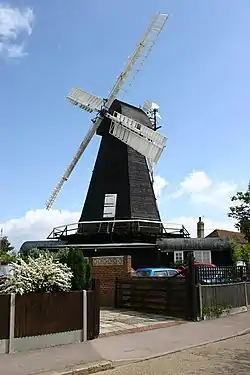| Herne | |
|---|---|
 | |
 Herne Location within Kent | |
| Population | 7,325 (2001)[1] (parish) |
| OS grid reference | TR181658 |
| Civil parish | |
| District | |
| Shire county | |
| Region | |
| Country | England |
| Sovereign state | United Kingdom |
| Post town | HERNE BAY |
| Postcode district | CT6 |
| Dialling code | 01227 |
| Police | Kent |
| Fire | Kent |
| Ambulance | South East Coast |
| UK Parliament | |
Herne /hɜːrn/ is a village in South East England, divided by the Thanet Way from the seaside resort of Herne Bay. Administratively it is in the civil parish of Herne and Broomfield in Kent. Between Herne and Broomfield is the former hamlet of Hunters Forstal. Herne Common lies to the south on the A291 road.
The hamlet of Bullockstone is about one mile to the west.
History
Medieval history
Archaeological excavations inside St Martin's Church at Herne in 1976 indicated that the first church there was similar to the earliest, Anglo-Saxon examples in Kent, such as those at Rochester, Canterbury, Reculver and Lyminge, and consisted of only a nave and an apsidal chancel.[2][3] The historian Nicholas Brooks noted that the Domesday Monachorum of 1087 or soon after lists Herne as the location of a minster, which is recorded nowhere else.[3][4] Brooks speculated that this referred to the church excavated in 1976, and that it may have been founded in the 7th or 8th century, but perhaps as late as the 11th century.[3] However, he regarded it as "perhaps most likely that the foundation of a [minster] at Herne should be attributed to the tenth century when attempts were being made to recover from the devastation of the Viking incursions."[3] A church at Herne is recorded as having been a chapelry belonging to St Mary's Church, Reculver, until 1310, when it became a parish church.[5]
Early modern history
In the 15th century Matthew Phillip, of a family based at nearby Greenhill, became a goldsmith in London, rising to become warden of the goldsmiths' guild there, and was Lord Mayor of London from 1463 to 1464.[6][7] He also owned Hawe Manor, a little under half a mile (733 m) north-east of Herne.[8] His second wife Christina was probably buried in a chapel dedicated to St John the Baptist, on the north side of the church, where a monumental brass was placed in her memory, dated 1470.[7] Hawe Manor was later home to John Fineux, Lord Chief Justice of the King's Bench from 1495 to 1526.[9][10] Nicholas Ridley was appointed vicar of Herne in 1538 by Archbishop Thomas Cranmer, who frequently occupied nearby Ford Palace, and collaborated with Ridley on the Forty-two articles of Religion; Ridley held the position until 1550.[11][12]
Amenities
Herne has infant and junior schools, and a post office.
In popular culture
Author Russell Hoban repurposes Bullockstone as "Bollock Stoanes" in his 1980, post apocalyptic novel Riddley Walker.[14]
References
- ↑ National Statistics Census 2001
- ↑ Philp & Gough 1976.
- 1 2 3 4 Brooks 1984.
- ↑ "Domesday Monachorum". Hull Domesday Project. n.d. Archived from the original on 5 November 2015. Retrieved 24 November 2016.
- ↑ Gough 1992, pp. 91–2.
- ↑ Noorthouck 1773, pp. 889–93.
- 1 2 Sparks 1984a, pp. 26–8.
- ↑ Sparks 1984a, p. 28.
- ↑ Sparks 1984b, p. 44.
- ↑ Campbell 1849, pp. 158–9.
- ↑ Duncombe 1784, pp. 107–8.
- ↑ Gough 2001, p. 254.
- ↑ "A local pub for local people: 'Micropubs' are catching on". The Independent. 17 February 2011. Archived from the original on 2 October 2016. Retrieved 12 December 2016.
- ↑ "Places – Riddley Walker Annotations". Errorbar. Archived from the original on 29 July 2021. Retrieved 21 August 2022.
Bibliography
- Brooks, Nicholas (1984), "The earliest church at Herne", in McIntosh, K.H.; Gough, H.E. (eds.), Hoath and Herne: The Last of the Forest, K. H. McIntosh, p. 14, ISBN 978-0-95024-237-8
- Bundock, Mike (2007), Historic Herne and Broomfield, Pierhead, ISBN 9781904661047
- Campbell, J. (1849), The Lives of the Chief Justices of England, from the Norman Conquest till the Death of Lord Mansfield, John Murray, hdl:2027/njp.32101062172679, OCLC 3462346
- Duncombe, J. (1784), "The history and antiquities of the two parishes of Reculver and Herne, in the county of Kent", in Nichols, J. (ed.), Bibliotheca Topographica Britannica, vol. 18, Nichols, pp. 65–161, OCLC 475730544
- Gough, H. (1992), "Eadred's charter of AD 949 and the extent of the monastic estate at Reculver, Kent", in Ramsay, N.; Sparks, M.; Tatton-Brown, T. (eds.), St Dunstan: His Life, Times and Cult, Boydell, pp. 89–102, ISBN 978-0-85115-301-8
- Gough, H. (2001), "The Archbishop's manor at Ford, Hoath" (PDF), Archaeologia Cantiana, 121: 251–68, ISSN 0066-5894, archived (PDF) from the original on 13 September 2015
- Noorthouck, J. (1773), "Addenda: The mayors and sheriffs of London", A New History of London including Westminster and Southwark, Baldwin, pp. 889–93, OCLC 938170595, archived from the original on 11 November 2016, retrieved 12 December 2016
- Philp, B.; Gough, H. (1976), "Early church discovered at Herne", Kent Archaeological Review (44): 86–91
- Sparks, M. (1984a), "Church life in medieval Herne", in McIntosh, K.H.; Gough, H.E. (eds.), Hoath and Herne: The Last of the Forest, K. H. McIntosh, pp. 24–9, ISBN 978-0-95024-237-8
- Sparks, M. (1984b), "Sir John Fyneux: A Herne worthy", in McIntosh, K.H.; Gough, H.E. (eds.), Hoath and Herne: The Last of the Forest, K. H. McIntosh, pp. 24–9, ISBN 978-0-95024-237-8
External links
![]() Media related to Herne, Kent at Wikimedia Commons
Media related to Herne, Kent at Wikimedia Commons
